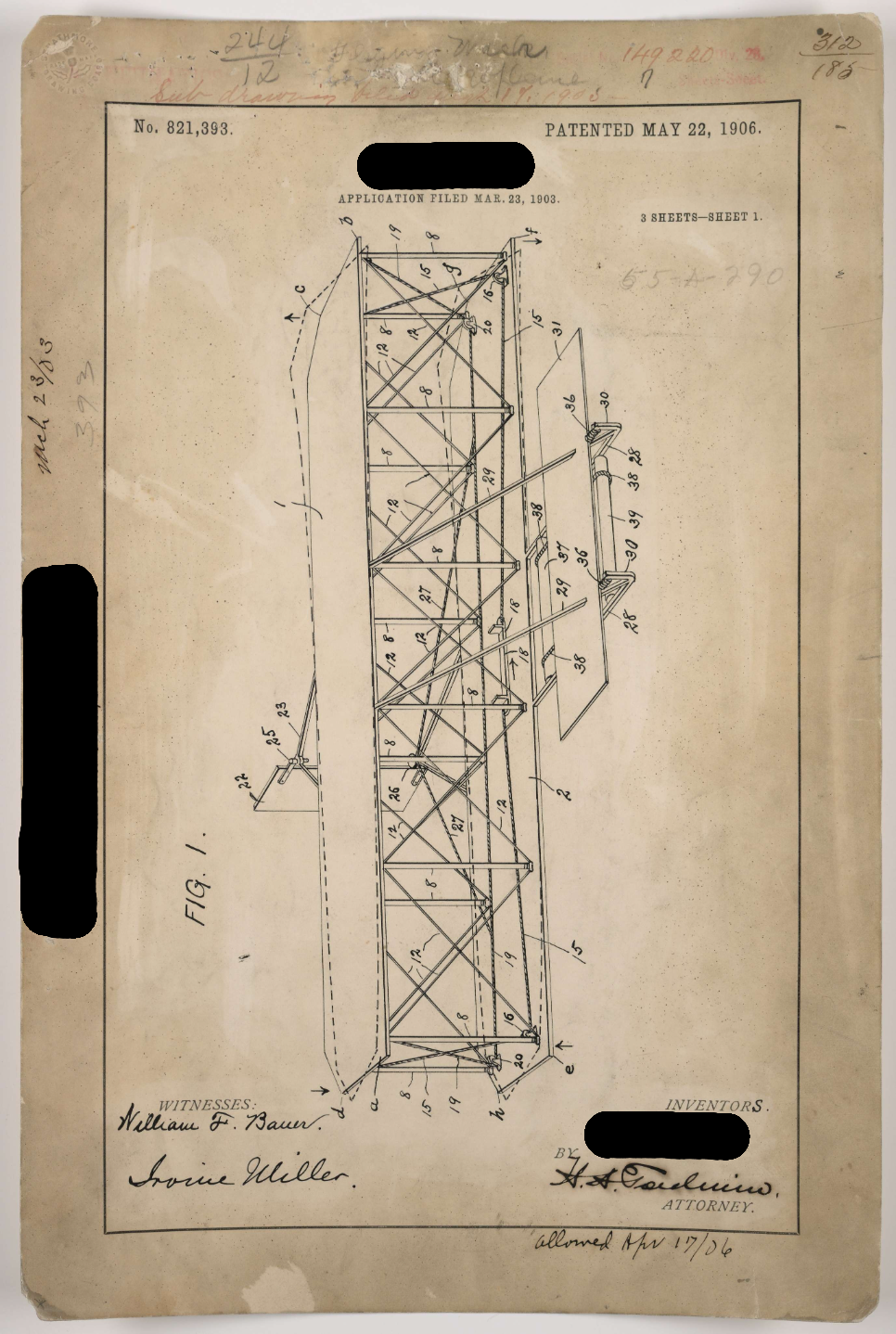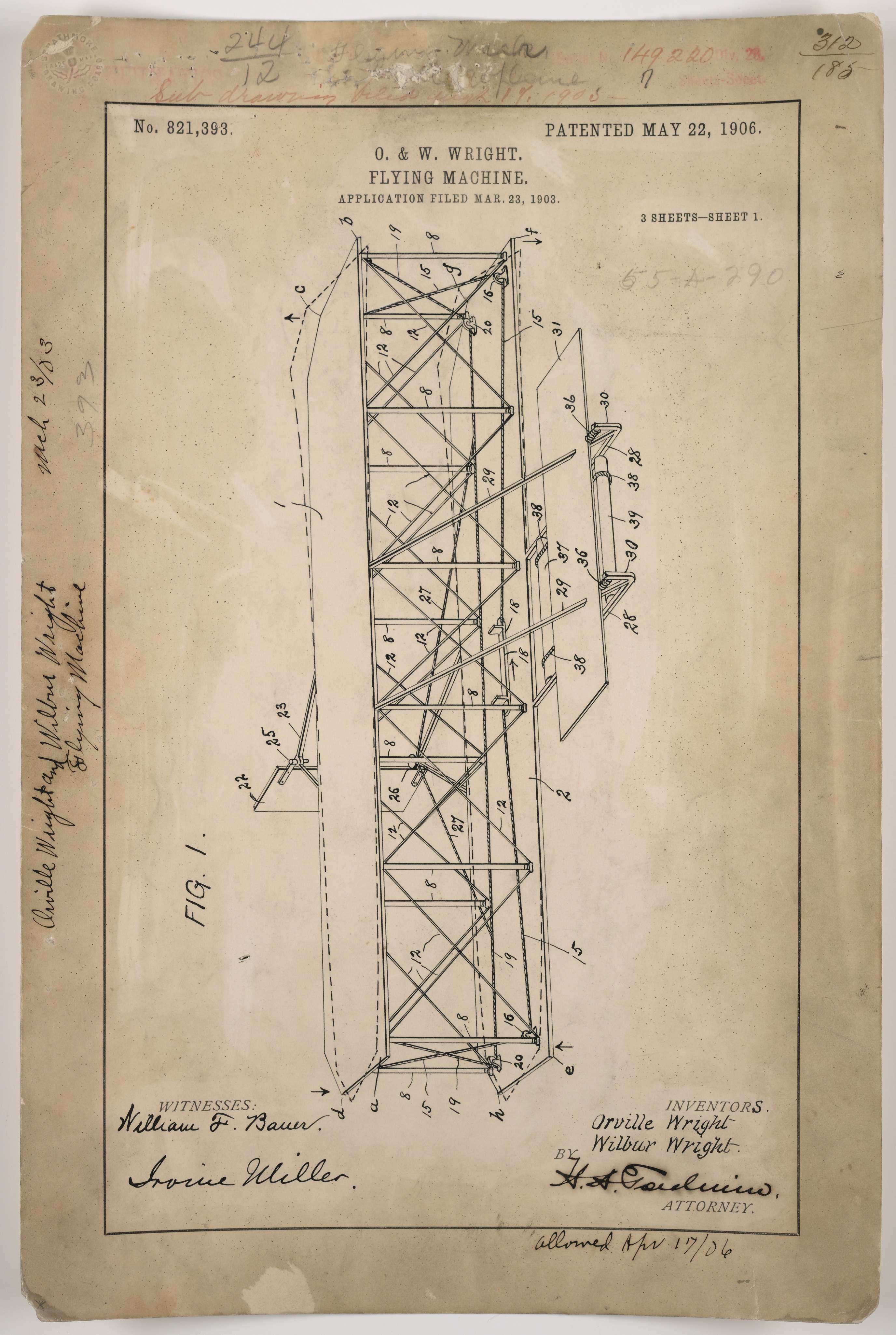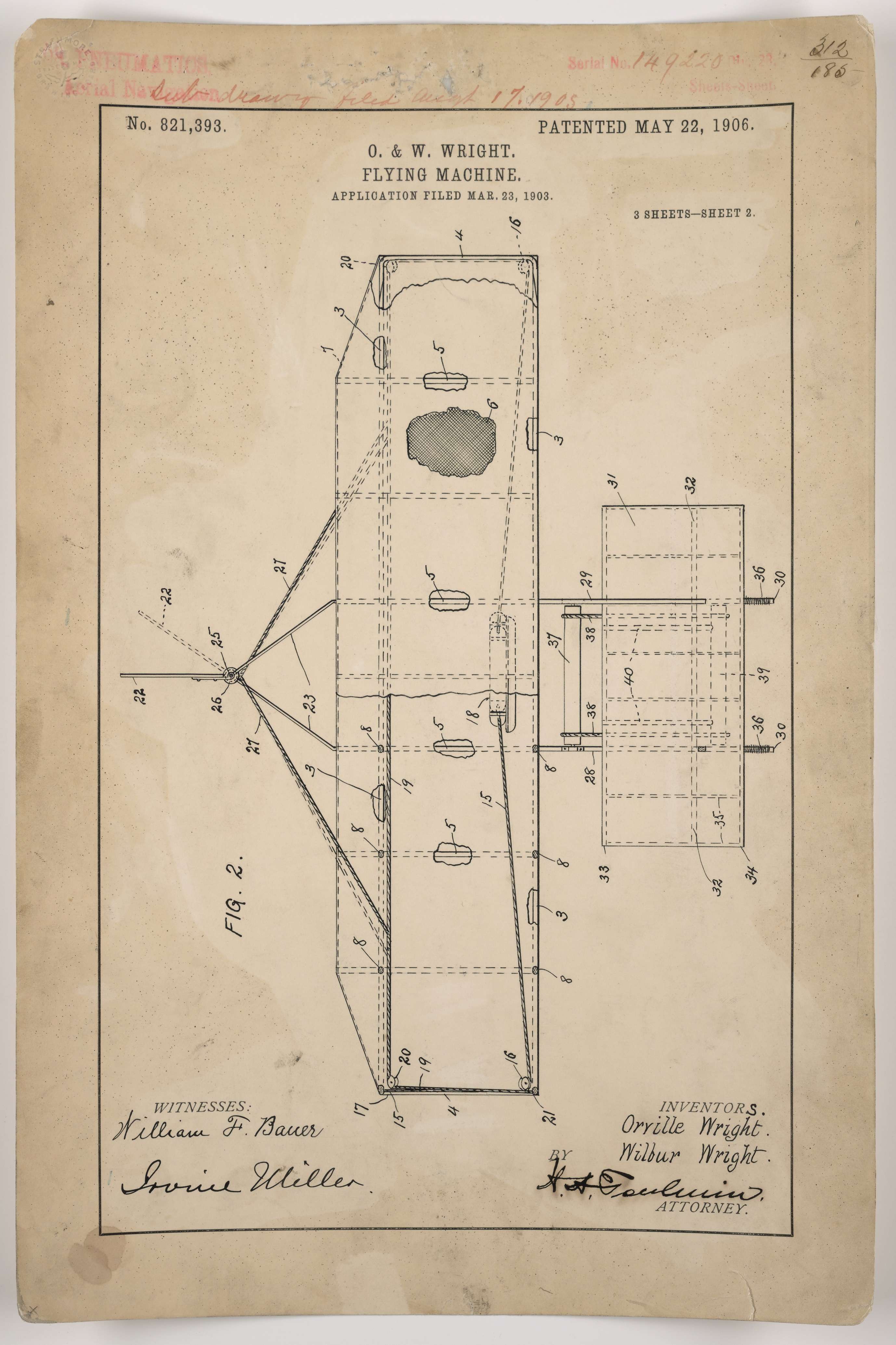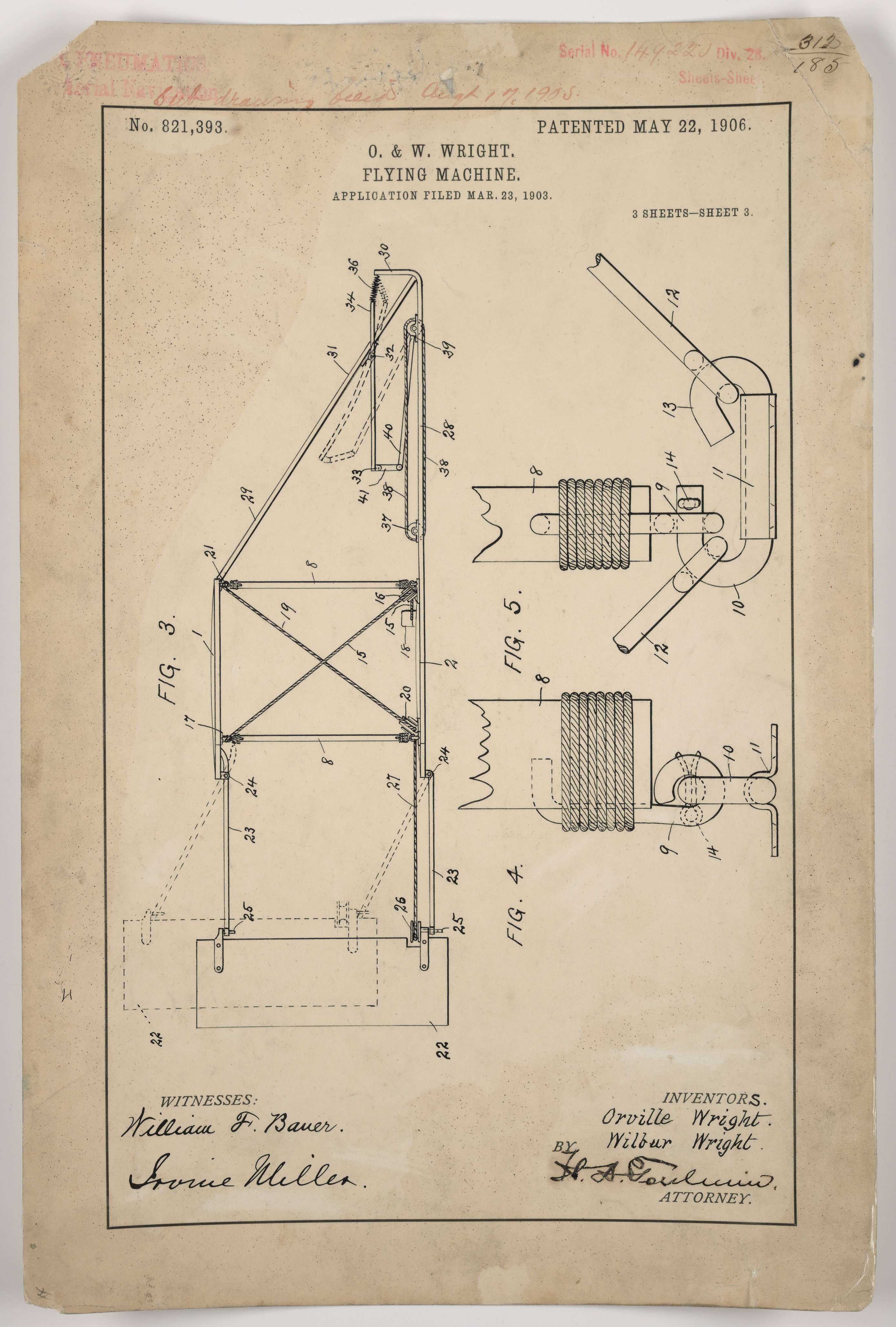What is Patent Number 821,393?
Focusing on Details: White Out/Black Out
All documents and text associated with this activity are printed below, followed by a worksheet for student responses.Introduction
You will see a patent drawing for an invention with its name and its inventors' names hidden.
Quickly scan this document. What do you notice first?
Name:
Class:
Class:
Worksheet
What is Patent Number 821,393?
Focusing on Details: White Out/Black Out
Examine the documents included in this activity and write your response in the space provided.
- Describe the document and the invention it depicts as if you were explaining it to someone who can’t see it.
- Based on what you can see, what do you think is the purpose of this invention? List evidence from the document to explain your opinion.
After you have made a hypothesis, click "View Entire Document" to reveal the invention.
Your Response
1
Activity Element
Patent Drawing for Flying Machine - Wright Brothers
Page 1

Conclusion
What is Patent Number 821,393?
Focusing on Details: White Out/Black Out
- How has this invention been used throughout history since the 1900s? How is it used today? How has it changed?
- What positive effects has this invention had over time?
- What negative effects has this invention had over time?
Your Response
Document
Patent Drawing for Flying Machine - Wright Brothers
5/22/1906
These drawings are from the patent file for the Flying Machine (or airplane) invented by Orville and Wilbur Wright of Dayton, Ohio.
The Wright brothers, like many aviation pioneers at the beginning of the 20th century, believed that powered flight was possible and that the only obstacle was achieving lateral control, the movement from side to side. The felt that control should depend on the pilot, much like how a rider balances a bicycle.
The brothers had high hopes for their first glider, believing the design to be sound and stable. Unfortunately, the wings didn't generate enough lift. Their improved design was a glider that worked well in level flight, but was hard to control and unpredictable, leading them to almost give up.
The 1902 Wright Glider represented all of the brothers' exhaustive research from their wind tunnel experiments. Improvements included a more efficient wingspan and the addition of moveable, vertical stabilizers on the rear of the craft to prevent side-to side movement (yaw) during turns. A moveable tail, combined with the horizontal stabilizer at the front and control of the wings, created a controllable aircraft, known today as the three axes of flight.
After conducting approximately one thousand glides during 1902, the brothers returned to Dayton confident that they could put a powered aircraft in flight during their next trip. They were so confident that once they returned to Dayton, they filed a patent for their flying machine in March 1903.
After three challenging and sometimes dangerous years, the brothers believed that 1903 would be the year that they achieved powered flight. They had to make critical refinements to their design, chiefly finding a power source. After failing to find an adequate commercial engine, they commissioned a machinist at their bicycle shop to build one. They designed their own propellers. They also needed to address weight. Their flying machine weighed nearly five times more than their 1902 glider, requiring a launching system to get it up to flying speed. Their setup consisted of a 60-foot wooden monorail on a dolly with two modified bicycle hubs and another hub attached to the front of the machine.
After arriving at Kitty Hawk in September 1903, the date of their attempt at powered flight was continually set back due to mechanical issues. After repairs were made, the Wright brothers attempted powered flight on December 14th. The pilot was decided by a coin toss, which Wilbur won. Unfortunately, during takeoff he oversteered, and the flyer climbed too steeply, stalled, and dove into the sand, necessitating more repairs.
On December 17th, 1903, with the winter weather beginning to set in, the brothers prepared for what would likely be their last attempt to achieve powered flight for the year. The wind was much stronger than they would have liked, but they pressed on. Since Wilbur had gotten the first turn, Orville took the controls for the second attempt. At 10:35 AM, Orville released the restraining wire and the flyer began rolling down the monorail and left the ground.
The brothers then took turns, flying three more times, increasing their distance as they familiarized themselves with the controls. After the fourth flight, a gust of wind caught the flyer, rolled it over and damaged it beyond simple repair. The flying season ended, but the Wright Brothers had achieved their famous first sustained flight.
The Wright brothers, like many aviation pioneers at the beginning of the 20th century, believed that powered flight was possible and that the only obstacle was achieving lateral control, the movement from side to side. The felt that control should depend on the pilot, much like how a rider balances a bicycle.
The brothers had high hopes for their first glider, believing the design to be sound and stable. Unfortunately, the wings didn't generate enough lift. Their improved design was a glider that worked well in level flight, but was hard to control and unpredictable, leading them to almost give up.
The 1902 Wright Glider represented all of the brothers' exhaustive research from their wind tunnel experiments. Improvements included a more efficient wingspan and the addition of moveable, vertical stabilizers on the rear of the craft to prevent side-to side movement (yaw) during turns. A moveable tail, combined with the horizontal stabilizer at the front and control of the wings, created a controllable aircraft, known today as the three axes of flight.
After conducting approximately one thousand glides during 1902, the brothers returned to Dayton confident that they could put a powered aircraft in flight during their next trip. They were so confident that once they returned to Dayton, they filed a patent for their flying machine in March 1903.
After three challenging and sometimes dangerous years, the brothers believed that 1903 would be the year that they achieved powered flight. They had to make critical refinements to their design, chiefly finding a power source. After failing to find an adequate commercial engine, they commissioned a machinist at their bicycle shop to build one. They designed their own propellers. They also needed to address weight. Their flying machine weighed nearly five times more than their 1902 glider, requiring a launching system to get it up to flying speed. Their setup consisted of a 60-foot wooden monorail on a dolly with two modified bicycle hubs and another hub attached to the front of the machine.
After arriving at Kitty Hawk in September 1903, the date of their attempt at powered flight was continually set back due to mechanical issues. After repairs were made, the Wright brothers attempted powered flight on December 14th. The pilot was decided by a coin toss, which Wilbur won. Unfortunately, during takeoff he oversteered, and the flyer climbed too steeply, stalled, and dove into the sand, necessitating more repairs.
On December 17th, 1903, with the winter weather beginning to set in, the brothers prepared for what would likely be their last attempt to achieve powered flight for the year. The wind was much stronger than they would have liked, but they pressed on. Since Wilbur had gotten the first turn, Orville took the controls for the second attempt. At 10:35 AM, Orville released the restraining wire and the flyer began rolling down the monorail and left the ground.
The brothers then took turns, flying three more times, increasing their distance as they familiarized themselves with the controls. After the fourth flight, a gust of wind caught the flyer, rolled it over and damaged it beyond simple repair. The flying season ended, but the Wright Brothers had achieved their famous first sustained flight.
This primary source comes from the Record Group 241: Records of the Patent and Trademark Office.
National Archives Identifier: 2524937
Full Citation: Patent Drawing for Flying Machine - Wright Brothers; 5/22/1906; 821393 - Flying Machine - Wright Brothers; Selected Patent Files, 1840 - 2005; Record Group 241: Records of the Patent and Trademark Office, ; National Archives at College Park, College Park, MD. [Online Version, https://www.docsteach.org/documents/document/flying-machine-wright-brothers, April 18, 2024]Patent Drawing for Flying Machine - Wright Brothers
Page 1

Patent Drawing for Flying Machine - Wright Brothers
Page 2

Patent Drawing for Flying Machine - Wright Brothers
Page 3

